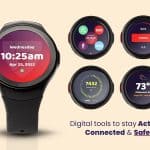Your medical monitoring system does require some basic testing from time-to-time to be sure that it’s functioning properly. Depending on your medical monitoring company, some of these tests are performed automatically for you so you don’t have to be concerned. Read our LifeStation reviews for a breakdown of this feature and more.
This first test is something that should be done when you first get the medical monitoring system up and running. This test is a range test. Its purpose is to get an idea of just how far your medical alert pendant or button can reach. If you find that your button can not reliably transmit to the medical monitoring console, then you should either move the console to a new location and re-test, or simply be aware of the limits of your particular system.
How To Properly Test The Range
- Contact your medical monitoring company and let them know that you will be testing your system.
- Start testing in rooms that are closer and move further out.
- Depending on your medical monitoring provider, each time you test your system, you will be speaking with a central station operator. That will confirm that they received your medical alert alarm.
- When testing, remember that you may need to close the doors between rooms or even to the outside to simulate real life activities.
- Don’t forget places like showers, bathtubs, basements, garages, and the outdoors. As for showers and tubs, get inside of them and close the shower door and the bathroom door, as you would normally. Remember, closed doors and windows limit range.
- If you have any other buttons, those should also be tested equally.
- Contact your medical monitoring company when your testing is complete.
Range tests do not have to be performed too often. I would suggest that you send a monthly test signal to your medical monitoring company. Each time you test, try it from a different place in your home.
Test Your System’s Main Console To The Monitoring Company
As we’ve stated in other articles and areas of our site, most good companies program this main console test feature automatically into their systems. Automatic monthly tests are good, but weekly tests are better (see the equipment section on our compare page or our detailed reviews for more information). We have been told that Walgreens medical alert will call you every 4-6 weeks to have you test your system to the monitoring center.
- If your medical monitoring company does not provide any automatic test, like Life Alert, then perform one range test weekly, but no longer than monthly.
- If your medical monitoring company provides a monthly test, like Philips Lifeline, then perform one range test weekly, but no longer than monthly.
- If your medical monitoring company provides a weekly test, like LifeStation, then perform one range test, monthly.
The reason we are having you perform a range test is to kill two birds with one stone. Each time you have a successful range test, then you have also successfully tested the main console to the central station. Don’t forget to test the console’s main emergency button, if you have one. If you have any other buttons, those should also be equally tested each cycle.
What About The Batteries in the Buttons?
Most reputable systems will send a special signal to the medical monitoring company when your medical alert pendant or button’s battery becomes low. Most are not replaceable by you, due to the waterproof features of these buttons. Contact your medical monitoring company if you have problems with your button or suspect that the battery may be low. Reduced range is a sign of a low battery.
What About Back-Up Power Batteries in the Main Console?
Again, most reputable systems will send a special signal to the medical monitoring company when your medical alert console’s battery becomes low. You may also have a trouble light illuminate if this condition exists. Contact your medical monitoring company if you have any questions or concerns.
These tests only take a few minutes of your time, but are an added safety measure you can’t live without.



